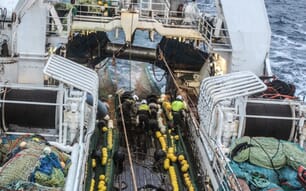Aquaculture Biosecurity Programme
Disease may come from any number of sources, for example viruses and bacteria. However it originates; its spreads through recognised vectors of infection. These include fish stock, staff and visitors, equipment, vehicles and transportation, other aquatic life, birds and animals, the aquatic environment and even the air itself.
Medication and vaccination have traditionally played a major role in treating diseases but it is now widely accepted that they cannot, in isolation, prevent losses due to disease. Modern farming demands a holistic approach. Unless the background challenge from disease causing organisms can be controlled, and good management practices strictly followed, medication and vaccination alone are not capable of adequately protecting fish stocks. Fish must be given an environment in which the level of infection is controlled to the point where vaccination and medication can achieve beneficial effects. Biosecurity is the key to achieving this.
Biosecurity involves the exclusion of disease-causing organisms from the environment. This is particularly important in fish production. It is achieved by the use of external and internal biosecurity barriers:
- External Barriers - blocking the spread of disease onto and off a fish farm
- Internal Barriers - blocking the spread of disease within the fish farm
The correct use and selection of disinfectants is very important and ensures that pathogen challenge is minimised, maximising the fish's natural defence against infection. This in turn will dramatically reduce incidences of disease, reducing mortality and saving you money.
There are three key factors that must b considered when selecting a disinfectant for fish farm biosecurity, these are:
- Proven Effiacy
- Environmental Impact
- Operator Safety
Proven Efficacy
Not all disinfectants are effective against the wide range of viral, bacterial and fungal disease causing organisms that affect fish production. Even disinfectants with similar chemistry can have widely different spectra of activity and effective dilution rates.
Selecting a disinfectant is therefore very important. Viral disease agents such as Infectious Anaemia Virus (ISA) are extremely persistent and difficult to destroy. The disinfectant must have independently proven efficacy against a wide range of aquaculture pathogens and be effective in low concentrations and at low temperatures.
Environmental Impact
As well as being effective, it is important that the disinfectant causes no harm to the environment in which it is being used.
Virkon S for aquaculture is environmentally friendly. Therefore, unlike most other disinfectants where strict discharge controls are essential, use of Virkon S for aquaculture will not constrain your daily activities.
Operator Safety
Given the exposure limits and dangers associated with the use of some disinfectants, particularly those based on glutaraldehyde and formaldehyde, consideration must be paid to operator safety. Virkon S for aquaculture has no occupationsl exposure limits and at a 1% in use dilution is classified as non irritant to skin and eyes.
Virkon S for aquaculture provides complete control for all aspects of fish farm biosecurity.




